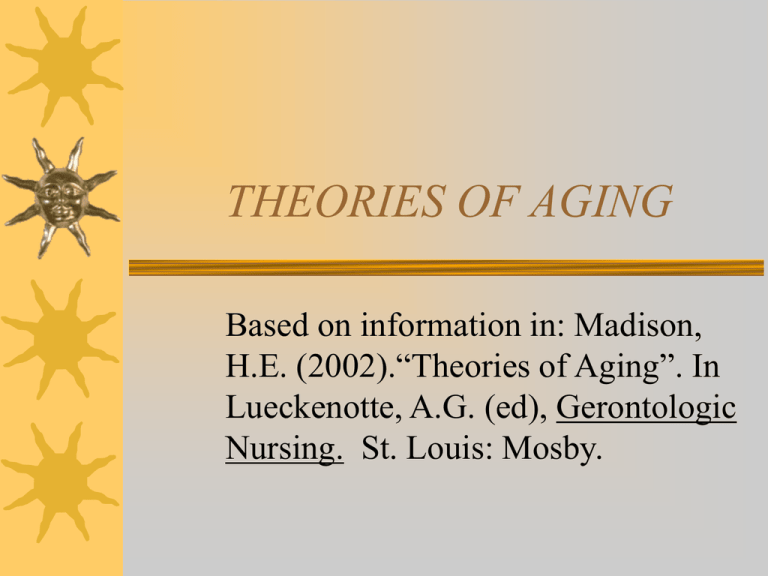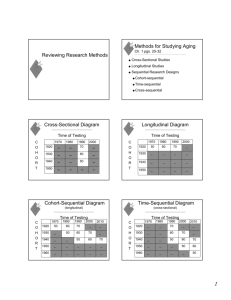THEORIES OF AGING
advertisement

THEORIES OF AGING Based on information in: Madison, H.E. (2002).“Theories of Aging”. In Lueckenotte, A.G. (ed), Gerontologic Nursing. St. Louis: Mosby. Theories of Aging: attempt to explain the phenomenon of aging as it occurs over the lifespan – aging is viewed as a total process that begins at conception – senescence: a change in the behavior of an organism with age leading to a decreased power of survival and adjustment Theories of Aging: Types Biologic Sociologic Psychologic Moral/Spiritual Biologic Theories: Concerned with answering basic questions regarding the physiological processes that occur in all living organisms as they chronologically age Foci of Biologic Theories Explanations of: – 1) deleterious effects leading to decreasing function of the organism – 2) gradually occurring age-related changes that are progressive over time – 3) intrinsic changes that can affect all member of a species because of chronologic age ALSO: – all organs in any one organism do not age at the same rate – any single organ does not necessarily age at the same rate in difference individuals of the same species Biologic Theories: Divisions Stochastic: Explain aging as events that occur randomly and accumulate over time Nonstochastic: View aging as certain predetermined, timed phenomena Stochastic Theories Error Theory Free Radical Theory Cross-Linkage Theory Wear & Tear Theory Error Theory Originally proposed in 1963 Basis: 1)errors can occur in the transcription in any step of the protein synthesis of DNA – 2) error causes the reproduction of an enzyme or protein that is not an exact copy – 3) As transcription errors to occur, the end product would not even resemble the original cell, thereby compromising its functional ability Error, cont’d More recently the theory has not been supported by research – not all aged cells contain altered or misspecified proteins – nor is aging automatically or necessarily accelerated if misspecified proteins or enzymes are introduced into a cell Free Radical Theory Free radicals are byproducts of metabolism--can increase as a result of environmental pollutants When they accumulate, they damage cell membrane, decreasing its efficiency The body produces antioxidants that scavenge the free radicals Free Rads, cont’d In animal studies, administration of antioxidants postpones the appearance of diseases such as cardiovascular disease and CA Free radicals are also implicated in the development of plaques associated with Alzheimer’s Cross-Linkage Theory Some proteins in the body become cross- linked, thereby not allowing for normal metabolic activities Waste products accumulate Result: tissues do not function at optimal efficiency C-L Theory, cont’d Some research supports a combination of exercise and dietary restrictions in helping to inhibit the cross-linkage process Wear & Tear Theory Proposed first in 1882 Cells simply wear out over time because of continued use--rather like a machine Would seem to be refuted by the fact that exercise in OA’s actually makes them MORE functional, not less Nonstochastic Theories: Programmed Theory Immunity Theory Programmed (Hayflick Limit) Theory Based on lab experiments on fetal fibroblastic cells and their reproductive capabilities in 1961 Cells can only reproduce themselves a limited number of times. Life expectancies are seen as preprogrammed within a species-specific range Immunity Theory Immunosenescence: Age-related functional diminution of the immune system Lower rate of T-lymphocyte (“killer cells”) proliferation in response to a stimulus & therefore a decrease in the body’s defense against foreign pathogens Immunity, cont’d Change include a decrease in humoral immune response, often predisposing older adults to: – 1)decreased resistance to a tumor cell challenge and the development of cancer – 2) decreased ability to initiate the immune process and mobilize defenses in aggressively attaching pathogens – 3) increased susceptibility to auto-immune diseases EMERGING THEORIES OF AGING Neuroendocrine Control (Pacemaker) Theory Metabolic Theory/Caloric Restriction DNA-Related Research Neuroendocrine Control “…examines the interrelated role of the neurologic and endocrine systems over the life-span of an individual”. (p. 24) there is a decline, or even cessation, in many of the components of the neuroendocrine system over the lifespan Neuro, cont’d Research has shown – 1) the female reproductive system is controlled by the hypothalamus. What are the mechanisms that trigger changes? – 2) adrenal glands’ DHEA hormone – 3) melatonin (from pineal gland)--a regulator of biologic rhythms and a powerful antioxidant. Declines sharply from just after puberty Metobolic Theory of Aging (Caloric Restriction) “…proposes that all organisms have a finite amount of metabolic lifetime and that organisms with a higher metabolic rate have a shorter lifespan”. (p. 24) Rodent-based research has demonstrated that caloric restriction increases the lifespan and delays the onset of agedependent diseases DNA-Related Research Major Developments: – Mapping the human genome (“…there may be as many as 200 genes responsible for contolling aging in humans”) – Discovery of telomeres SOCIOLOGIC THEORIES OF AGING Disengagement Theory Activity/Developmental Task Theory Continuity Theory Age Stratification Theory Person-Environment Fit Theory Changing FOCUS of Sociological considerations of aging: – 60’s focus on losses and adaptation to them – 70’s broader global, societal, and structural factors influencing lives of OA’s – 80’s-90’s exploration of interrelationships between OA’s and their physical, political, environmental & socioeconomic mileau Disengagement Theory Cumming & Henry--1961 Aging seen as a developmental task in and of itself, with its own norms & appropriate patterns of behavior “appropriate” behavior patterns involved a mutual agreement between OA’s and society on a reciprocal withdrawal. No longer supported Activity Theory (Developmental Task Theory) Havighurst, Neugarten, Tobin ~1963 “Activity is viewed by this theory as necessary to maintain a person’s life satisfaction and a positive self-concept”. (p.27) Activity, cont’d Theory based on assumptions: – 1) it’s better to be active than inactive – 2) it is better to be happy than unhappy – 3) an older individual is the best judge of his or her own success in achieving the first two assumptions Continuity Theory How a person has been throughout life is how that person will continue through the remainder of life Old age is not a separate phase of life, but rather a continuation and thus an integral component Age Stratification Theory Riley--1985 Society consists of groups of cohorts that age collectively The people & Roles in these cohorts change & influence each other, as does society at large Thus, there is a high degree of interdependence between older adults & society Person-Environment Fit Theory Lawton, 1982 Individuals have personal competencies that assist in dealing with the environment: – – – – ego strength level of motor skills individual biologic health cognitive & sensory-perceptual capacities P-E Fit, cont’d As a person ages, there may be changes in competencies & these changes alter the ability to interrelate with the environment Significant implications in a society that is characterized by constantly changing technology PSYCHOLOGIC THEORIES OF AGING Maslow’s Hierarchy of Human Needs Jung’s Theory of Individualism Erikson’s Eight Stages of Life Peck’s Expansion of Erikson’s Theory Selective Optimization with Compensation Maslow’s Hierarchy of Human Needs Maslow--1954 “…each individual has an innate internal hierarchy of needs that motivates all human behaviors”. (p. 29 depicted as a pyramid; the ideal is to achieve self-actualization, having met all the “lower” level needs successful “Maslow’s fully developed, self-actualized person displays high levels of all of the following characteristics: perception of reality; acceptance of self, others, and nature; spontaneity; problem-solving ability; self-direction; detachment and the desire for primacy; freshness of peak experiences; identification with other human beings;……. …satisfying and changing relationships with other people; a democratic character structure; creativity; and a sense of values. Only about 1% of us are truly ideal self- actualized persons Jung’s Theory of Individualism Carl Jung--1960 origins are Freudian Self-realization is the goal of personality development as individual ages, each is capable of transforming into a more spiritual being Erikson’s Eight Stages of Life 1993 Stages throughout the life course. Each represents a crisis to be resolved. For OA’s: – 40 to 65 (middle adulthood): generativity versus self-absorption or stagnation – 65 to death (older adulthood): ego integrity versus despair Erikson, cont’d “Self-absorbed adults will be preoccupied with their personal well-being and material gains. Preoccupation with self leads to stagnation of life” “Unsuccessful resolution of the last crisis may result in a sense of despair in which individuals view life as a series of misfortunes, disappointments, and failures”. (p.30) Peck’s Expansion of Erikson’s Theory Erikson’s last two stages are expanded to 7 The final three of the developmental tasks for old age: – ego differentiation versus work role preoccupation – body transcendence versus body preoccupation – ego transcendence versus ego preoccupation Selective Optimization with Compensation Baltes--1987 Individuals develop strategies to manage losses of function that occur over time Selective Optimization, cont’d 3 Interacting Elements: – selection: increasing restriction of one’s life to fewer domains of functioning – optimization: people engage in behaviors to enrich their lives – compensation:developing suitable, alternative adaptations THE END! Thanks for hanging in there!


